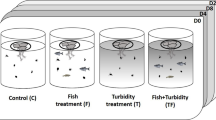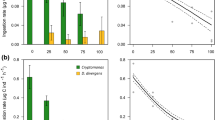Abstract
Net production of zoobenthos in two shallow and eutrophic lakes, i.e. the S-basin of Mývatn, Iceland (maximum depth 4.2 m, mean depth 2.3 m) and Hjarbæk Fjord, Denmark (maximum depth 6.5 m, mean depth 1.9 m) were calculated as 878 and 1093 kJ m-2 yr-1, respectively. The zoobenthos in both lakes was dominated by Chironomidae (Diptera) living partly as filtrators feeding on suspended particles (phytoplankton) and partly as surface feeders foraging on benthic algae and/or seston. Respiration and consumption were estimated from the literature. Net production efficiency averaged 0.41 and 0.48 in Hjarbæk Fjord and Mývatn, respectively. Ingestion was dominated by herbivorous chironomids, while detritivorous tubificids were insignificant. Zoobenthic production made up 86% of total secondary production (zooplankton plus zoobenthos) in both lakes. The trophic efficiency between net primary production and benthic net secondary production was 8% and 11% in Hjarbæk Fjord and Lake Mývatn S-basin, respectively.
Similar content being viewed by others
References
Alimov, A. F., 1991. Structiral and functional characteristics of aquatic animal communities. Int. Revue ges. Hydrobiol. 76: 169–182.
Armitage, P. D., 1968. Some notes on the food of the chironomid larvae of a shallow woodland lake in South Finland. Ann. zool. fennici 5: 6–13.
Benke, A. C., 1984. Secondary production of aquatic insects. In V. H. Resh & D. M. Rosenberg (eds), The ecology of aquatic insects. Praeger, New York: 289–322.
Berg, M. B., 1993. Larval food and feeding behaviour. In P. D. Armitage, P. S. Cranston & L. C. V. Pinder (eds), Chironomidae, biology and ecology of non-biting midges. Chapman & Hall (in press).
Berrie, A. D., 1976. Detritus, micro-organisms and animals in fresh water. In J. M. Anderson & A. McFayden (eds), The role of terrestrial and aquatic organisms in decomposition processes. Blackwell Scientific, Oxford: 323–338.
Brinkhurst, R. O., K. E. Chua & N. K. Kaushik, 1972. Interspecific interactions and selective feeding by tubificid oligochaetes. Limnol. Oceanogr. 17: 122–133.
Bullock, T. H., 1955. Compensation for temperature in the metabolism and activity of poikilotherms. Biol. Rev. 30: 311–342.
Cummins, K. W. & J. C. Wuycheck, 1971. Caloric equivalents for investigations in ecological energetics. Mitt. int. Ver. Limnol. 18: 1–158.
Hamburger, K. & P. C. Dall, 1990. The respiration of common benthic invertebrate species from the shallow littoral zone of Lake Esrom, Denmark. Hydrobiologia 199: 117–130.
Heal, O. W. & S. F. MacLean Jnr., 1975. Comparative productivity in ecosystem-secondary productivity. In W. H. van Dobben & R. H. Lowe-McConnell (eds), Unifying concepts in ecology. Dr W. Junk Publishers, The Hague: 89–108.
Humphreys, W. P., 1979. Production and respiration in animals populations. J. anim. Ecol. 48: 427–453.
Hunding, C., 1979: The oxygen balance of Lake Mývatn, Iceland. Oikos 32: 139–150.
Ivlev, V., 1939. Transformation of energy by aquatic animals. Coefficient of energy consumption by Tubifex tubifex (Oligochaeta). Int. Revue ges. Hydrobiol. 38: 449–459.
Ivleva, I. V., 1980. The dependence of crustacean respiration rate on body mass and habitat temperature. Int. Revue ges. Hydrobiol. 65: 1–47.
Johnson, M. G. & R. O. Brinkhurst, 1971. Benthic community metabolism in Bay of Quinte and Lake Ontario. J. Fish. Res. Bd Can. 28: 1715–1725.
Johnson, R. K., B. Boström & W. van de Bund, 1989. Interaction between Chironomus plumosus (L.) and the microbial activity in surficial sediments of a shallow eutrophic lake. Limnol. Oceanogr. 34: 992–1003.
Jónasson, P. M., 1979. The Lake Mývatn ecosystem, Iceland. Oikos 32: 289–305.
Jónasson, P. M., 1984. The ecosystem of eutrophic Lake Esrom. In F. B. Taub (ed.), Lakes and Reservoirs. Ecosystem of the World 23: 177–204.
Jónasson, P. M., 1992. The ecosystem of Thingvallavatn: a synthesis. Oikos 64: 405–434.
Jónasson, P. M. & H. Adalsteinsson, 1979. Phytoplankton production in shallow eutrophic Lake Mývatn, Iceland. Oikos 32: 113–138.
Jónasson, P. M. & C. Lindegaard, 1979. Zoobenthos and its contribution to the metabolism of shallow lakes. Arch. Hydrobiol. Beih. Ergebn. Limnol. 13: 162–180.
Jónasson, P. M. & C. Lindegaard, 1988. Ecosystem studies of North Atlantic Ridge lakes. Verh. int. Ver. Limnol. 23: 394–402.
Jónasson, P. M., C. Lindegaard, P. C. Dall, K. Hamburger & H. Adalsteinsson, 1990a. Ecosystem studies on temperate lake Esrom and the subarctic lakes Mývatn and Thingvallavatn. Limnologica 20: 259–266.
Jónasson, P. M., C. Lindegaard & K. Hamburger, 1990b. Energy budget of Lake Esrom, Denmark. Verh. int. Ver. Limnol. 24: 632–640.
Kajak, Z. & J. Warda, 1968. Feeding of benthic non-predatory Chironomidae in lakes. Ann. zool. fennici 5: 57–64.
Kozlovsky, D. G., 1968. A critical evaluation of the trophic level concept. I. Ecological efficiencies. Ecology 49: 48–60.
Krebs, C. J., 1985. Ecology. The experimental analysis of the distribution and abundances. Harper & Row, New York, 3rd edn., 800 pp.
Lindegaard, C., 1989. Secondary production of zoobenthos in freshwater ecosystems. A review with special reference to Chironomidae (Diptera). Acta Biol. Debr. Oecol. Hung. 3: 231–240.
Lindegaard, C., 1992a. Zoobenthos ecology of Thingvallavatn: vertical distribution, abundance, population dynamics and production. Oikos 64: 257–304.
Lindegaard, C., 1992b. The role of zoobenthos in energy flow in deep, oligotrophic Lake Thingvallavatn, Iceland. Hydrobiologia 243–244/Dev. Hydrobiol. 79: 185–195.
Lindegaard, C. & P. M. Jónasson, 1979. Abundance, population dynamics and production of zoobenthos in Lake Mývatn, Iceland, Oikos 32: 202–227.
Lindegaard, C. & E. Jónsson, 1983. Succession of Chironomidae (Diptera) in Hjarbæk Fjord, Denmark, during a period with change from brackish water to freshwater. Mem. Am. ent. Soc. 34: 169–185.
Lindegaard, C. & E. Jónsson, 1987. Abundance, population dynamics and high production of Chironomidae (Diptera) in Hjarbæk Fjord, Denmark, during a period of eutrophication. Ent. scand. Suppl. 29: 293–302.
Mason, C. F. & R. J. Bryant, 1975. Periphyton production and grazing by chironomids in Alderfen Broad, Norfolk. Freshwat. Biol. 5: 271–278.
McLachlan, A. J., 1977. Some effects of tube shape on the feeding of Chironomus plumosus L. (Diptera: Chironomidae). J. anim. Ecol. 46: 139–146.
McNeil, S. & J. H. Lawton, 1970. Annual production and respiration in animal populations. Nature 225: 472–474.
Moss, B. & M. Timms, 1989. Predation, sediment stability and food availability as determinants of the benthic invertebrate fauna in two shallow lakes. Hydrobiologia 185: 249–257.
Olrik, K., S. Lundøer & K. Rasmussen, 1984. Interactions between phytoplankton, zooplankton and fish in the nutrient rich shallow lake Hjarbæk Fjord, Denmark. Int. Revue ges. Hydrobiol. 69: 389–405.
Rasmussen, K., 1982. Hjarbæk Fjord undersøelse 1981–82. Rapport nr. 3: Vandkemi, primærproduktion og sedimentkemi. Viborg Amtskommune.
Rasmussen, K., 1990. Some positive and negative effects of stocking whitefish on the ecosystem redevelopment of Hjarbæk Fjord, Denmark. Hydrobiologia 200–201/Dev. Hydrobiol. 61: 593–602.
Sarvala, J., V. Ilmavirta, L. Paasivirta & K. Salonen, 1981. The ecosystem of the oligotrophic Lake Pääjärvi 3. Secondary production and an ecological energy budget of the lake. Verh. int. Ver. Limnol. 21: 454–459.
Scavia, D., 1988. On the role of bacteria in secondary production. Limnol. Oceanogr. 33: 1220–1224.
Schroeder, L., 1981. Consumer growth efficiencies: their limits and relationships to ecological energetics. J. theor. Biol. 93: 805–828.
Strayer, D., 1988. On the limits to secondary production. Limnol. Oceanogr. 33: 1217–1220.
Strayer, D. & G. E. Likens, 1986. An energy budget for the zoobenthos of Mirror lake, New Hampshire. Ecology 67: 303–313.
Szczepanski, A., 1965. Deciduous leaves as a source of organic matter in lakes. Bull. Acad. Pol. Sci. Cl. II, 13: 215–217.
Titmus, G. & R. Badcock, 1981. Distribution and feeding of larval Chironomidae in a gravel-pit lake. Freshwat. Biol. 11: 263–271.
Walshe, B. M., 1951. The feeding habits of certain chironomid larvae (subfamily Tendipedinae). Proc. Zool. Soc. Lon. 121: 63–79.
Walter, R. A., 1976. The role of benthic macrofauna in the structure and function of the Mirror lake ecosystem. M. S. thesis, Cornell University, Ithaca, N.Y., 206 pp.
Waters, T. F., 1977. Secondary production in inland waters. Adv. Ecol. Res. 10: 91–164.
Welch, H. E., 1968. Relationships between assimilation efficiencies and growth efficiencies for aquatic consumers. Ecology 49: 755–759.
Author information
Authors and Affiliations
Rights and permissions
About this article
Cite this article
Lindegaard, C. The role of zoobenthos in energy flow in two shallow lakes. Hydrobiologia 275, 313–322 (1994). https://doi.org/10.1007/BF00026722
Issue Date:
DOI: https://doi.org/10.1007/BF00026722




